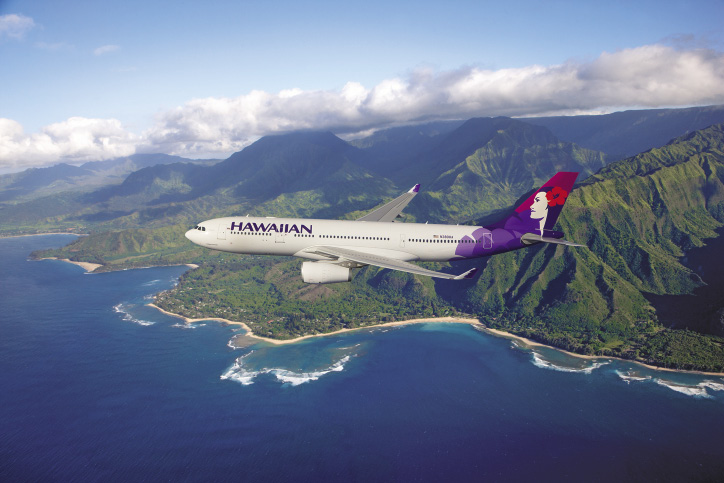- Home
- Media Kit
- Current Issue
- Past Issues
- Ad Specs-Submission
- Ad Print Settings
- Reprints (PDF)
- Photo Specifications (PDF)
- Contact Us

![]()
ONLINE

The Strength of Hawaii
Editors’ Note
Mark Dunkerley has held his current posts since June 2005. He served as President and Chief Operating Officer of Hawaiian Holdings, Inc. since February 2003 and its subsidiary, Hawaiian Airlines, Inc., since December 2002. From August 2001 to March 2002, he served as Chief Operating Officer of the Sabena SA in Brussels, Belgium. From 1999 to 2000, he served as Chief Operating Officer and President of Worldwide Flight Services, and from 1989 to 1999, he held a variety of management positions with British Airways including Senior Vice President for British Airways’ Latin America and Caribbean division. Prior to joining British Airways, he served as the Assistant to the Chief Executive Officer of Miami International Airport. He has been a Director of Hawaiian Holdings, Inc. since June 2005. Dunkerley serves on the Board of Directors of Hawaii Visitors and Convention Bureau and Hawaii Business Roundtable. He served as a Director of Worldwide Flight Services from 1999 to 2000. He earned a bachelor’s degree in economics from the London School of Economics in 1984 and a master’s degree in Aeronautics from the Crane Institute of Technology in 1985.
Company Brief
In recent years, Hawaiian Airlines, Inc. (www.hawaiianairlines.com) has been the nation’s highest-ranked carrier for service quality and performance in the annual Airline Quality Rating study. Hawaiian has also led all U.S. carriers in on-time performance for each of the past seven years as reported by the U.S. Department of Transportation. In its 82nd year of continuous service in Hawaii, Hawaiian is the largest provider of passenger air service to Hawaii from the state’s primary visitor markets on the U.S. mainland. A subsidiary of Hawaiian Holdings, Inc., Hawaiian offers nonstop service to Hawaii from more U.S. gate-way cities than any other airline, as well as service to South Korea, Japan, the Philippines, Australia, American Samoa, and Tahiti. Hawaiian also provides approximately 150 daily jet flights between the Hawaiian Islands.
When you joined Hawaiian Airlines at a time of turbulence in the market, what made you feel this was the right fit for you?
First, as a tourist destination, Hawaii is without peer in the world. I had every reason to believe that would continue and I have that same level of confidence going forward.
Second, I knew there was room in the airline space for an airline that focused on a destination if that destination was strong enough.
Third, when I looked at the competitive landscape in and out of Hawaii, it was apparent that, notwithstanding the fact that Hawaiian’s results had been poor, all of the basic ingredients of success were there.

Hawaiin Airline A330
How challenging was it when you came onboard to create a vision that people could rally around?
That is always the big challenge, particularly when you go into a situation where a company has been around for a long time and has not been doing well for a long time. The sense of it being preordained that things won’t go well becomes deep-rooted in the organization.
There wasn’t a single moment where we suddenly moved from one side of the aisle to the other. But when I arrived, we looked for something we could change that wasn’t big and largely strategic, but which was relatively short-term and extremely emblematic, to build confidence, to demonstrate as a matter of internal messaging that we don’t have to be second to anybody. The thing we chose was punctuality.
At that time, the airline’s three-letter designator HAL had become colloquially known as standing for “Hawaiian’s Always Late.” We said, we’re going to slay this dragon and we’re not going to be average – we’re going to be the industry leader.
Curiously, and purely as a byproduct, it has become an important part of our external messaging since then.

Haneda high tea
Within Asia, where are you most focused and how broad are the opportunities there?
There are two types of markets for Hawaii and Asia: there is Japan, which is a very large and mature market, and there is everywhere else. That means developing markets, where the amount of traffic isn’t very high at the moment, but where all the macro-indicators suggest that over the long term, these markets are going to be significant.
Today, in Northeast Asia, we serve Japan and Korea. Korea has ridden out the recession perhaps better than any other country in the world and we have high hopes for them.
Will China be a focus?
We hope so. There is a great deal of opportunity in China. The biggest impediment we have today when it comes to China is the difficulty that Chinese nationals have in securing tourist visas to visit the U.S.
Many passengers today complain about the food product, especially for U.S. carriers. How critical is that to the experience?
First, it is an important part of the Hawaiian host culture to provide food. It is a signal of welcoming and part of everyday life in Hawaii.
But beyond that, it is important because it transmits a sense of value to customers. Most of our competitors spend a lot of time focused on business travel and they pay varying degrees of lip service to people traveling on vacation.
Our stock in trade is people traveling on vacation. The people in Economy are traveling with their families, engaged in what is probably the second largest household expenditure of their entire year, after their mortgage. To send a signal that you are not sufficiently valuable to us as a customer to warrant basic sustenance is a powerful negative message. Conversely, providing food says, we value your business and we know the personal sacrifices that you’ve made to be here.
Over the past 24 months when you have had strong results compared to the industry, has the strength of Hawaii as a destination been the key factor?
As a business, we try all kinds of things to diversify our risk. We’re flying to Asia and we have a lot of business coming from the U.S. mainland to Hawaii. But at the end of the day, how Hawaii does, so does Hawaiian Airlines.
In this difficult economy, one of the surprising things was the resilience of Hawaii as a destination. We had a much lower reduction in demand than almost any other destination anywhere in the world, which speaks to the strength of Hawaii as a destination.•